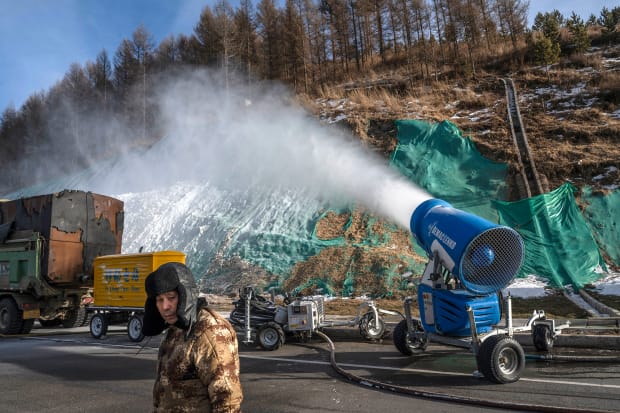Welcome to SI Climate, our ongoing series about how sports are adapting to—and affecting—our changing world.

Inside the Legends Suite Club at Yankee Stadium, Allen Hershkowitz was sipping cabernet and recounting a video meeting he led for sustainability officials for the Qatar 2022 World Cup. An environmental scientist who also advises the NBA and MLS, Hershkowitz works full-time for the Yankees overseeing their sustainability efforts, the first person to hold that type of role in U.S. professional sports. He’s become a go-to authority for teams, leagues and other organizations looking for direction on green initiatives. So in September 2021, when a colleague working with the World Cup organizers asked him to brief the Qatari group on best climate practices, Hershkowitz was eager to say yes.
This particular World Cup—featuring seven new stadiums, a new metro system and a (literal) small nation’s worth of new air conditioning units, all brought to you by sponsors like QatarEnergy, the state-owned oil and gas giant—has long been a notoriously climate-unfriendly affair. During Hershkowitz’s presentation, one of the Qatar representatives spoke up with a bold claim: “We plan to announce that we’re going to be carbon neutral and plastic neutral.”
Hershkowitz recoiled at the suggestion: “I said, ‘Please do not do that. Do not do that.’”
Alas, he was too late. The day before, Qatar’s Supreme Committee for Delivery & Legacy (SC) boasted in a press release that it would “deliver a plastic-neutral tournament,” going on to explain that by “physically removing plastic waste from rivers and oceans . . . the amount recovered will be equivalent to the plastic waste generated from the hosting of the FIFA World Cup.”

Illustration by Davide Barco
While this particular post later disappeared from Qatar 2022’s official website—fishing out old soda bottles does not negate the environmental impact of fabricating massive amounts of new plastic—the World Cup organizer has continued to tout its tournament as carbon neutral. This despite the fact that, by its own conservative calculation, staging the 28-day tournament will generate 3.6 million metric tons of carbon dioxide, an increase of 67% from Russia 2018.
Qatar 2022 carbon neutral? “There’s no way in the world,” Hershkowitz says, adding, “There’s no such thing as plastic neutral.”
A spokesman for the SC responded, “We committed in our sustainability strategy to deliver the world’s first carbon-neutral FIFA World Cup, and we are on track to meet this goal.” The spokesman also listed Qatar 2022’s green initiatives and said it would buy “certified and recognized” carbon credits to offset unavoidable emissions.
To climate experts such as Hershkowitz, though, this playbook represents a classic case of what is known as greenwashing. “Greenwashing is the notion that you’re signaling virtuous behavior with respect to environmental objects, often climate, but in reality it’s just a signal,” says Roger Pielke, professor of environmental studies at the University of Colorado.
The corporate world is awash in such behavior—JetBlue, for example, brags about carbon-neutral flights, a literally impossible feat for non-avians—and sports is catching up.
On one hand, the direct environmental impact of sports tends to be more limited than people may think: According to data analyzed by Pielke and his colleagues, the collective annual emissions of the NFL, NBA and NHL account for just about a minute and a half of the U.S.’s annual footprint.
On the other hand, the sports world is rife with teams, leagues and organizations failing to fulfill even the most basic aspects of their environmental commitments. Certainly no scientist expects the World Cup—or any other league, team or tournament—to solve climate change. But several who spoke to Sports Illustrated said sports can play a positive role.
As many of these experts noted, sports organizations possess unparalleled influence over fans, not to mention considerable leverage over sponsors and business partners. What they say and do matters. Especially when they say one thing and do another.

Matthew Ashton/AMA/Getty Images
In October 2017, representatives from both the sports and environmental science worlds converged on Bonn, Germany, for a two-day United Nations workshop. The organizers were curious whether the sports groups in attendance—among them FIFA, UEFA and the Philadelphia Eagles—could use their platforms to speak to fans about the urgent need for climate action. But the response was clear: The teams and leagues felt like they couldn’t talk before improving their own efforts.
From those conversations, the U.N.’s Sports for Climate Action Framework was born. Unveiled at the following year’s U.N. climate summit, the initiative lacked concrete targets at its onset by design. Instead, the framework bound signatories to intentionally broad principles, including a pledge to “reduce overall climate impact.” The framework also instructed signatories to calculate a baseline footprint by measuring greenhouse gas emissions as a “starting point.”
In short order, sports organizations raced to put their brand names to the framework: More than 300 of them signed on, ranging from large federations like the IOC to leagues like the NBA and the NFL, to clubs like the Yankees, Warriors and Liverpool FC, to smaller outfits like Grandma’s Marathon in Duluth, Minn., and the Austrian Ocean Race Project.
“We had five principles that were quite broad, but we knew that all of these different sports organizations are at different levels of maturity,” says Lindita Xhaferi-Salihu, the sectors engagement lead on sports and fashion at the United Nations Framework Convention on Climate Change (UNFCCC), the branch that oversees the program. “They will all have different ways to influence those emissions or not. They will have different capacities. We told them, there it is, five principles. Create a plan based on those. ... We have to all start from somewhere. We, in this journey, we need all hands on the deck.”
Many of the signatories were eager to brag about their commitments to the program, soaking up the good publicity. But far fewer actually followed through on their promises. One year after the framework was instituted, in 2019, the UNFCCC conducted a survey asking whether signatories were measuring greenhouse gas emissions. “At that time, there were 249 signatories,” says Hershkowitz, who participated in one of the framework’s working groups. “Over 60% had not begun the measurement process.”
The UNFCCC is starting to crack down. Last year, the body began requiring signatories to file a report that detailed their organization’s emissions and the actions being taken to reduce them. Yet Xhaferi-Salihu says that roughly a third of signatories failed to do that. Those organizations that didn’t report by the end of August lost their accreditation with the framework.
Going forward, she adds, public reporting of emissions will be required to maintain signatory status. In a departure from its more lenient earlier guidelines, late last year the UNFCCC also set hard targets for new signatories, including reducing greenhouse gas emissions by 50% by 2030 and reaching net zero by ’40. Soon, all signatories will have to adopt those benchmarks; not doing so could lead to being booted from the program, Xhaferi-Salihu says.
Hershkowitz, for his part, does not currently advise his clients to publicly report their impact data. There is too much disagreement on how indirect impacts should be measured—for instance, how you measure the emissions from fans traveling to games, or from making the plastic cups sold at stadiums, or even from the production of the ball—he says. “You want to make sure that whatever you put out in the public is true and verifiable,” he says. “The NBA, the Yankees and MLS—I have told them we’re not going public with it. . . . Right now, getting that data is a moving target.”
For Xhaferi-Salihu, though, that type of explanation doesn’t wash. For progress, she believes, there must be public accounting, even if imperfect. “If you sign up as a sports organization and then you think that by putting a signature, you’re done, and by maybe using your Twitter now and then, you’re done—I don’t think that does it,” she says. “Sustainability, at the end of the day, unfortunately, it’s not just about storytelling; it is about numbers.”

Kevin Frayer/Getty Images
The truth is, many of the sports organizations that signed onto the U.N. framework are good arguments that more accountability is needed.
Ahead of the last Winter Games, for instance, the IOC issued breathless press releases heralding how every venue in Beijing would be fully powered by renewable energy, but it glossed over how Beijing 2022 diverted groundwater to make the 1.2 million cubic meters of fake snow that carpeted every ski slope or that it bulldozed part of a mountainous nature reserve to build the bobsled, skeleton and luge center. “Sustainability in the Olympics has . . . significantly declined over time,” an academic paper in the spring 2021 edition of the journal Nature concluded.
The sports world is full of similarly performative actions, from one-off composting nights at stadiums to the fleet of battery-powered, hydrogen-fueled trucks that delivered beer to SoFi Stadium for Super Bowl LVI. But the most common move in the greenwashing playbook, according to experts, is to buy carbon offsets.
While some types of offsets purchased by companies are productive, many are viewed by experts as worse than useless. There is what Texas A&M professor of sport management Brian McCullough describes as a cottage industry of “rogue, non-legitimate carbon offset programs” that lure teams and other clients with cheap costs and easy PR but lack transparency as to how that money is actually helping the environment. McCullough adds that offsets based on planting new trees—one of the most common types—are particularly problematic, as a tree takes decades to mature and begin absorbing carbon from the atmosphere yet does nothing to help with the emissions supposedly being offset today. “It’s really the Wild Wild West,” McCullough says.
He argues that buying offsets should be a “last-case scenario” for a sports organization, but he sees many starting their green efforts by cutting a check. “It’s a quick fix,” he says. Furthermore, the fuzzy math often involved in calculating offsets can lead to even more exaggerated claims. “To claim carbon neutrality is quite frankly B.S., but a lot go down that path because it becomes an institutionalized practice,” he says. “One team does it, then others follow.”
McCullough encountered this in 2019, when he was working at Seattle University and the MLS’s Sounders declared themselves the first carbon-neutral soccer team in North America and the first carbon-neutral pro sports team in the U.S. Trying to check their underlying data, though, McCullough hit a roadblock: The team, he says, wouldn’t share numbers. The Sounders declined comment to SI.

Carbon offsets are far from the only issue. Hershkowitz, for his part, casts an especially skeptical eye toward the many teams and leagues getting in bed with cryptocurrency, calling the industry’s carbon footprint an ecological disaster. (Bitcoin alone, according to the University of Cambridge, consumes an estimated 97.93 terawatt hours of electricity per year—outpacing the entire country of Belgium.) Hershkowitz recalls trying to educate one U.S. pro team on crypto’s environmental impacts: He says the club’s head of marketing replied, “I don't believe you, and we're not changing anything.”
At the Aspen Institute’s inaugural climate change conference in May, NBA commissioner Adam Silver stated the goal of the league—as one of the signatories of the U.N. framework—is to halve greenhouse gas emissions by 2030 and reach net zero by ’40. At the same time, though, Silver positioned the NBA at the front of the industry-wide charge toward cryptocurrencies, with the league signing an estimated four-year, $192 million deal in October ’21 with the exchange platform Coinbase. Also last year, Crypto.com forked over $700 million to rename the Staples Center in Los Angeles while FTX took over as title sponsor for the Heat’s arena in Miami.
An NBA spokesman did not respond directly to questions about how the league’s crypto partnerships square with its sustainability commitments, but touted the work the league has done to promote environmental awareness and “minimize our footprint” over the last 15 years, since it created its NBA Green program. “Through our partnerships, we are exploring ways that we can work together to address and mitigate our respective environmental impact while also raising awareness around sustainability globally, the spokesman said. “We recognize that we, along with society, have much more work to do.”
Of course, plenty of teams and leagues have partnerships with carbon-intensive industries, like oil companies (Aramco is a Formula One global partner) and airlines. Hershkowitz and many experts view those types of sponsor relationships as a critical tool for achieving sustainable solutions that a team can’t accomplish on its own. They see opportunities for teams to push their partners toward a more sustainable path.
Overall, McCullough says, “progress hasn’t been where you’d think it should be” in the sports world. Part of this is a function of a relative lack of resources: Dedicated staff, operational buy-in and potentially cost-prohibitive equipment (a top-of-the-line dashboard can run upward of $5 million, though budget solutions exist) are all required just to track emissions data. “You do see teams really taking it seriously,” he says, “but because of internal limitations, it’s slower than if Amazon comes on the scene and says, ‘This is an important initiative. We have the capacity to hire a 50-person team.’”
Then again, while minor league clubs or small-time college programs might struggle to measure up, it goes without saying that top-level sports leagues are multibillion-dollar operations. “The sports industry is obviously focused on on-field performance and getting butts in seats,” McCullough says. He believes teams will truly act on environmental issues only if fans push them. “It’s been a wait-and-see,” he says. “What are fans going to want?”

Dustin Bradford/Getty Images
So what should fans demand from their favorite teams and leagues? And what role should sports be playing?
McCullough urges teams and venues to increase their commitment to renewable energy while decreasing dependence on fossil fuels, pointing to the entirely wind- and solar-powered Johan Cruijff Arena in Amsterdam, home of the top-tier soccer club AFC Ajax, as one shining example. But, as McCullough notes, those types of measures address sports’ direct impact but do little to strike at broader forces. “The sport industry is dependent on other industries,” McCullough says. “Travel is that elephant in the room.”
Seth Wynes, a postdoctoral researcher of climate solutions at Concordia University, observed one potential solution on this front in 2020, during the first year of the COVID-19 pandemic, as the four major North American men’s leagues (NFL, NBA, MLB, NHL) all dramatically—if inadvertently—cut their emissions by way of various schedule adjustments (canceling overseas trips, grouping games by region, increasing the number of “baseball-style” series). If these changes were made permanent, Wynes later concluded in a study that ran in the November 2021 issue of Environmental Science & Technology, “air travel emissions reductions of 22% each year could be expected.”
Earlier this summer, at a sports conference in Odense, Denmark, Pielke took the stage and delivered a talk titled, “How Not to Greenwash.” Near the end, below a bullet point describing carbon offsets as “gimmicks,” Pielke listed three broader “alternatives” for sports organizations looking to make an environmental impact: “educate fans about the scale of the issue”; “promote policies that work to decarbonize energy systems”; and “consider other [environmental social governance] objectives beyond climate where action of sports organizations can have a more direct impact.”
Put another way, he was asking sports organizations to use their considerable social and financial capital for good.
“The biggest plus that sports has is the influence over fans,” says Dave Newport, director of the Environmental Center at the University of Colorado. Teams can “empower fans to be more sustainable at home, work and play,” he says.
Since 2008, Newport has also led the charge at Colorado, launching the first dedicated sustainability program inside a Division I athletics department. One result: At CU football games, the university says 90% of waste is now diverted.
Newport believes businesses’ making overly exuberant claims about environmental policies is actually a good sign. “Personally, I love greenwashing,” he says, “because it’s the first step toward real action. You get caught, you take a hit in sales, you have to clean it up.
“I don’t really care what the motives are, so long as it’s real. The atmosphere doesn’t give a s--- about how the carbon got up there. Just how much.”







